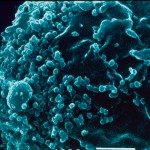Link to Pubmed [PMID] – 7538252
Virology 1995 Apr;208(2):784-8
We have shown previously that trophoblast cells from human placenta can be infected with HIV-1 and a productive infection established. Recently, (1991, J. Virol. 65, 2102-2107) Zachar et al. and D. M. Phillips and X. Tan (1992, AIDS Res. Hum. Retroviruses 8, 1697-1705) have described in vitro infection of choriocarcinoma cell lines. Using choriocarcinoma cell lines (JAR, BeWo, and FD25, a trophoblast-derived cell line) we have infected these cells with several laboratory strains of virus and have shown that this can be prevented either by sCD4 or by antibodies to CD4. This provides strong evidence that the infection may be through CD4. In addition, we have found that infection of JAR and FD25 cells by HIV-1/Lai was enhanced in the presence of human antisera to HIV-1. This supports an additional role for immunoglobulin receptors (Fc-R) in the entry of virus into the cell. We report here evidence that CD4 and Fc-R on the cell surface play crucial roles in the entry of HIV into such placenta-derived cell lines.

